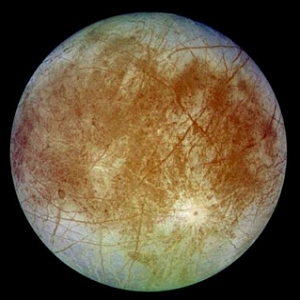
|
Europa
This image shows Jupiter's ice-covered moon Europa.
Dark brown areas show uncovered rocky material
from the interior while the bright icy plains in the
polar areas (top and bottom) are shown in shades of
blue.
It is thought that a liquid ocean, and possibly even life, may exist
beneath the ice on Europa.
The long, dark lines are fractures in the crust, some of
which are more than 3,000 kilometers (1,850 miles) long. The bright feature
with a
central dark spot in the lower third of the image is a young impact crater
some 50 kilometers (31 miles) in diameter.
Europa is about 3,160 kilometers (1,950 miles) in diameter, or about the size of
Earth's moon. This image was taken by NASA's Galileo spacecraft.
|







